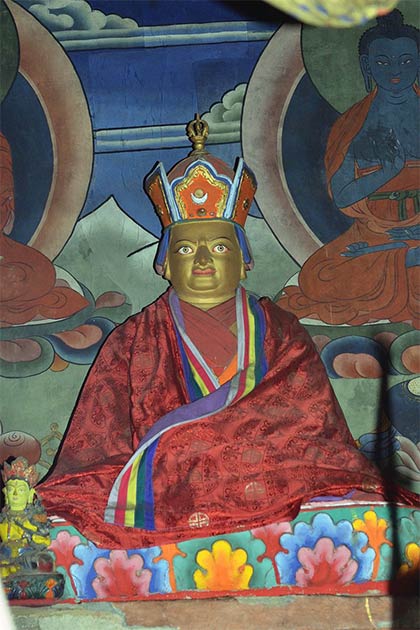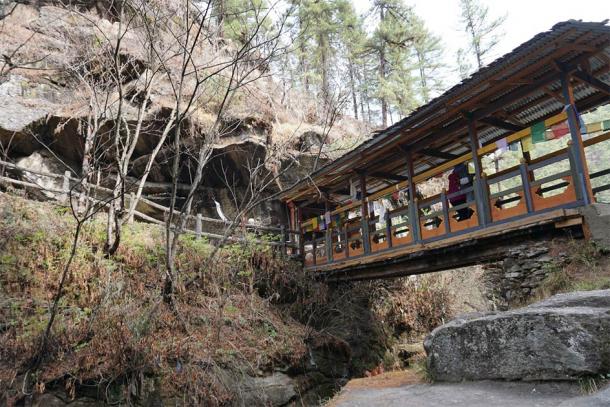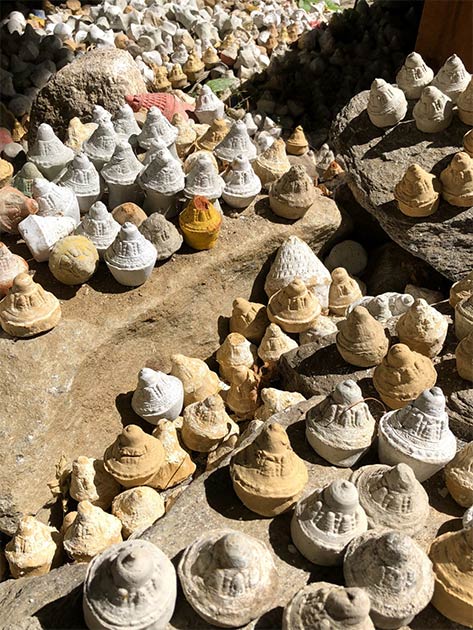Bhutan’s sacred Burning Lake (known also as Membartsho or Mebar Tsho), in the Tang Valley, gets its name from a legend involving Pema Lingpa (or Padma Lingpa), a renowned Bhutanese saint. Today, the Burning Lake is not only visited by pilgrims, but also by tourists. In previous years, mishaps have occurred at the site, resulting in a number of unfortunate drownings at the Burning Lake.
According to legend, the Burning Lake was the site where Pema Lingpa made two of his most famous discoveries. Pema Lingpa is said to have been born in 1450 AD, and, according to some, was the reincarnation of one of the disciples of Padmasambhava, known also as Guru Rimpoche (more about him later). As a child, Pema Lingpa became an apprentice to a blacksmith, and subsequently, he spent most of his young adult life working in that trade. Despite being interested in religion, Pema Lingpa did not have the opportunity to pursue his interests at that time. It was only at the age of 25 that he began his religious journey . In that year, Pema Lingpa had a prophetic dream, but he was unable to make any sense out of it.

The tranquil waters of the Burning Lake in Bhutan, a place of miracles that still attracts thousands today! Source: Brian Weed / Adobe Stock
The Saint Pema Lingpa And The Burning Lake Legend
Two years later, on the “tenth day of the second month of the Monkey year,” Pema Lingpa fell asleep at the Maṇi Gonpa. He was awakened by a loud voice, and when he opened his eyes, he saw before him a monk dressed in shabby clothes. The monk handed Pema Lingpa a scroll and asked him to read it. Once Pema Lingpa took the scroll, the monk disappeared.

Statue of the Bhutanese Saint Pema Lingpa, who made the Burning Lake a sacred site, in a temple in Tsakaling Gewog, Bhutan. (Christopher J. Fynn / CC BY-SA 3.0 )
According to one version of the legend, the mysterious monk was none other than Padmasambhava, the legendary Buddhist master who lived during the 8 th century AD. Padmasambhava is credited with the introducing Tantric Buddhism to Tibet, and the establishment of the first monastery there. Padmasambhava is also said to have hidden “termas” (secret teachings or treasures) at various sites. These teachings were meant to be found later on, so that they could be passed down to future generations. The first of Padmasambhava’s termas was found as early as 1125 AD. The Burning Lake was one of the places where Padmasambhava hid his termas.
How Pema Lingpa Found The First Two Sacred Termas
Returning to the story of Pema Lingpa, the scroll handed to him contained some instructions. The saint was told to bring five friends with him to Naring Drak (the Burning Lake as it was previously called) during the night of a full moon, where he would discover his destiny beneath a rock. Additionally, the scroll contained a key to decode the termas (108 in total, according to some sources).
Pema Lingpa obeyed the instructions on the scroll and went to Naring Drak with his five friends at the appointed time. Suddenly, Pema Lingpa stripped naked, and jumped into the small lake beneath the cliff. According to legend, the saint found a large underwater cave, within which were a throne and a pile of scrolls. The cave’s guardian took one of the scrolls, gave it to Pema Lingpa, and told him to leave. In one version of the legend, the guardian of the cave was an old woman with one eye, and a life-size statue of the Buddha sat on the throne. In any case, when the saint arrived at the surface of the water, he was propelled up to the top of a cliff by a force that resembled a strong wind.
According to one account of the legend, Pema Lingpa showed the scrolls to his parents and two Buddhist masters from the Tharpaling monastery. None of them, however, could read its text. Using the key given to him by the monk, however, Pema Lingpa was able to decode the terma, which is considered to be the first one he discovered. Pema Lingpa discovered many other termas, and, eventually, he returned to Naring Drak or the Burning Lake to find one more.

An ancient bridge that crosses over the gorge at Bhutan’s Burning Lake. (David / Adobe Stock )
In spite of all that he had done, not everyone was convinced by Pema Lingpa’s authenticity, including the area’s governor. When Pema Lingpa arrived at the Burning Lake (Naring Drak), the governor assembled a large group of people at the lake and told the saint that if he brought a terma from the lake, he would support him. On the other hand, if Pema Lingpa failed to do so, he would be punished as a charlatan. The saint, Pema Lingpa, raised the stakes by grabbing a burning butter lamp, proclaiming that if he were genuine, he would come back with the treasure, and the lamp would still be burning. On the other hand, if he were a fraud, he would drown.
Needless to say, Pema Lingpa succeeded and in addition to the lamp that was still burning, he brought up a small box crafted from joint skulls, and a small sculpture. As a result of this miraculous feat, the governor doubted no more, and all who were present became his followers. It was also due to this incident that Naring Drak was renamed as Membartsho. Pema Lingpa went on to discover many other termas during his lifetime, though the two that he revealed at the Burning Lake are arguably his most famous.

Tsha-tsha clay offerings left by Buddhist pilgrims at the Burning Lake. (YWL / Adobe Stock )
The Burning Lake Becomes A Sacred Pilgrimage Site
As a result of Pema Lingpa’s association with the place, as well as the discovery of the two termas there, the Burning Lake became a sacred site, which it still is today. Evidence of the Burning Lake’s sacred status include the many prayer flags strewn across the gorge, as well as numerous small clay offerings (known as ‘tsha-tsha’) that are placed by pilgrims in the rock niches there. Apart from its sacredness, the Burning Lake is also visited for its natural beauty by tourists.
Unfortunately, in previous years, mishaps have happened at the site, resulting in the loss of life. An article from 2015, for instance, reported that a French tourist fell into the Burning Lake whilst taking photos. Although the local guide jumped into the lake, and managed to push the tourist ashore, the tourist died shortly after, as a result of excess water inhalation. The guide was washed away by the currents. The same report claims that plans to protect the safety of tourists at the site failed to materialize, and that tourists themselves sometimes disregard warnings of danger. It is not clear, however, if the situation has improved . . .
Top image: The tranquil waters of the Burning Lake in Bhutan, a place of miracles that still attracts thousands today! Source: Brian Weed / Adobe Stock
By Wu Mingren
References
Daily Bhutan, 2020. The Mystery Of Mebar Tsho-The Burning Lake Of Bhutan. [Online]
Available at: https://dailybhutan.com/article/the-mystery-of-mebar-tsho-the-burning-lake-of-bhutan
Gould, R., 2020. The Burning Lake. [Online]
Available at: https://www.atlasobscura.com/places/the-burning-lake
Lonely Planet, 2020. Membartsho. [Online]
Available at: https://www.lonelyplanet.com/bhutan/tang-valley/in-location/sights/212204d0-8aea-4414-8118-7ec4c4b07793/a/nar/212204d0-8aea-4414-8118-7ec4c4b07793/1335543
Lonely Planet, 2020. Pema Lingpa’s Burning Lake. [Online]
Available at: https://www.lonelyplanet.com/bhutan/tang-valley/background/other-features/e95d88b2-01aa-4a12-8280-98d89d9f89d7/a/nar/e95d88b2-01aa-4a12-8280-98d89d9f89d7/1335543
Maki, A., 2011. Pema Lingpa. [Online]
Available at: https://treasuryoflives.org/biographies/view/Pema-Lingpa/3000
The Editors of Encyclopaedia Britannica, 2018. Padmasambhava. [Online]
Available at: https://www.britannica.com/biography/Padmasambhava
Tourism Council of Bhutan, 2020. Mebar Tsho – The Burning Lake. [Online]
Available at: https://www.bhutan.travel/attractions/mebar-tsho-the-burning-lake
Wangdi, T., 2015. Tourist and guide drown in Mebartsho. [Online]
Available at: https://kuenselonline.com/tourist-and-guide-drown-in-mebartsho/
Related posts:
Views: 0
 RSS Feed
RSS Feed
















 October 3rd, 2020
October 3rd, 2020  Awake Goy
Awake Goy  Posted in
Posted in  Tags:
Tags: 
















